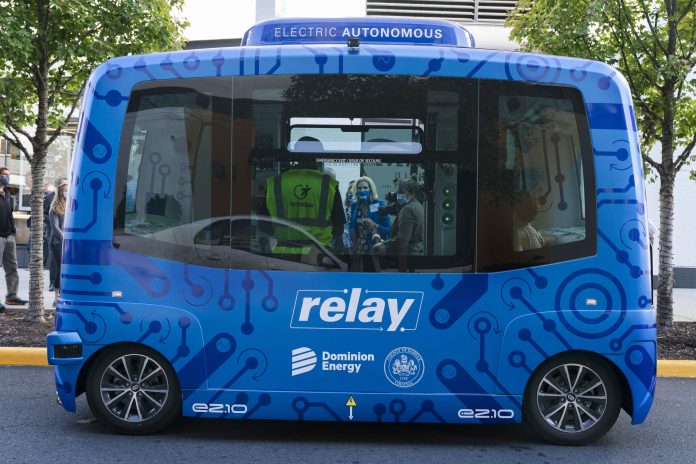The future of transportation arrived in northern Virginia, looking like a big blue toaster on wheels that seats six and drives itself through the region’s notorious traffic.
State and local officials debuted the Relay system Thursday, an all-electric, autonomous vehicle that will provide free shuttle rides back and forth from the Dunn Loring Metrorail stop to the bustling Mosaic District in Fairfax County.
The shuttle is “the sort of thing we’d see in a Star Wars or a Blade Runner movie, without the vertical liftoff,” said Mark Webb, chief innovation officer at Dominion Energy, a partner in the project.
It is the first publicly funded electric, autonomous shuttle in Virginia, officials said. Similar pilot projects are up and running in different places across the country, but what makes the Relay shuttle somewhat unique is the environment in which it will operate. While some projects are limited to college campuses or operate in dedicated lanes, this shuttle will mix with real traffic in a particularly busy section of Fairfax County.
“This is not a one-off, not a demonstration in a parking lot,” said Kathy McGhee, director of transportation research and innovation in the state transportation department.
She said the project will provide valuable data on basic functions like the vehicle’s battery life in a real working environment, the cost of the electricity needed to fuel the vehicle, and how the shuttles operate in an environment studded with cars, pedestrians and traffic lights.
The shuttle is starting off small: While it seats six, only three will be allowed at any one time because of the coronavirus unless they are all members of the same family. It will run only from 10 a.m. to 2 p.m. Monday through Thursday, and its speed won’t exceed 10 mph (16 kph) , even though it will run on roads with 25 mph (40 kph) limits.
The shuttles do indeed drive themselves, but safety operators are on board and can override the shuttle’s autonomous features.
Daniel Carney — a safety operator for Transdev, which runs the shuttles — estimated that during testing he had to override the controls about once for every 2-mile roundtrip loop. The most common issue is the shuttle’s inability to steer itself around obstacles.
For example, Carney said that if people do a poor job parallel parking on the side streets on which Relay operates, the shuttle will stop. He then steps in and uses a joystick to navigate around the parked car so it continue on its way.
And the shuttle’s slow speed does produce agitation from motorists stuck behind it, said Carney, who will occasionally deal with glares or worse from fed-up drivers who decide to go around the shuttle.
“I just shrug like, ‘I don’t know what you want me to do about it,'” Carney said. “It’s sort of out of my hands.”
County leaders said they’re happy to be at the forefront of an emerging technology, but that the shuttle also fills a real need of “last mile” transportation, connecting a busy Metrorail site with a retail district that is about a mile away, a little farther than most are willing to walk.
The project is funded with a $200,000 state grant and a $50,000 match from Fairfax County.




















